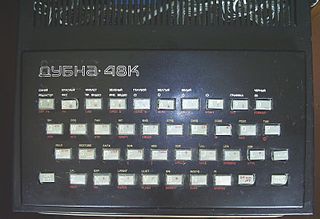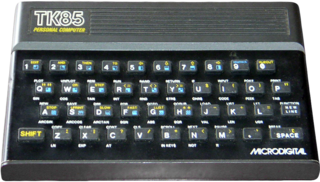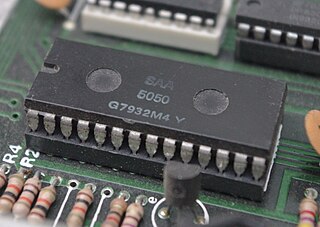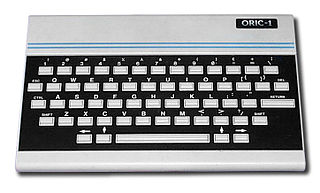
The Acorn Electron was a lower-cost alternative to the BBC Micro educational/home computer, also developed by Acorn Computers Ltd, to provide many of the features of that more expensive machine at a price more competitive with that of the ZX Spectrum. It had 32 kilobytes of RAM, and its ROM included BBC BASIC II together with the operating system. Announced in 1982 for a possible release the same year, it was eventually introduced on 25 August 1983 priced at £199.

The Jupiter Ace by Jupiter Cantab was a British home computer released in 1982. The Ace differed from other microcomputers of the time in that its programming environment used Forth instead of the more popular BASIC. This difference, along with limited available software and poor character based graphic display, limited sales and the machine was not a success.

The TRS-80 Micro Computer System is a desktop microcomputer launched in 1977 and sold by Tandy Corporation through their Radio Shack stores. The name is an abbreviation of Tandy Radio Shack, Z80 [microprocessor]. It is one of the earliest mass-produced and mass-marketed retail home computers.

The Atari 8-bit computers, formally launched as the Atari Home Computer System, are a series of 8-bit home computers introduced by Atari, Inc. in 1979 with the Atari 400 and Atari 800. The architecture is designed around the MOS Technology 6502 CPU and three custom coprocessors which provide support for sprites, smooth multidirectional scrolling, four channels of audio, and other features. The graphics and sound are more advanced than most of its contemporaries, and video games are a key part of the software library. The 1980 first-person space combat simulator Star Raiders is considered the platform's killer app.

The Commodore PET is a line of personal computers produced starting in 1977 by Commodore International. A single all-in-one case combines a MOS Technology 6502 microprocessor, Commodore BASIC in read-only memory, keyboard, monochrome monitor, and, in early models, a cassette deck.

The Atari Portfolio is an IBM PC-compatible palmtop PC, released by Atari Corporation in June 1989. It was the first palmtop computer compatible with the IBM PC ever released.

The TRS-80 Model 100 is a notebook-sized portable computer introduced in April 1983. It was the first commercially successful notebook computer, as well as one of the first notebook computers ever released. It features a keyboard and liquid-crystal display, in a battery-powered package roughly the size and shape of a notepad or large book. The 224-page, spiral-bound User Manual is nearly the same size as the computer itself.
The Psion Series 7 is a subnotebook computer from Psion that was released in 2000. In size it is fairly original: larger than a palmtop or handheld machine, but smaller than a laptop computer. It was the first and last of the Psion series to have a full color electronic visual display. It has a leather-bound clamshell design, with a touch-sensitive, Video Graphics Array (VGA) resolution liquid-crystal display (LCD) and QWERTY computer keyboard. Internally it has a 132.71 MHz StrongARM SA-1100 processor, 16 megabyte (MB) of random-access memory (RAM) and 16 MB of internal read-only memory (ROM).

The Dubna 48K is a Soviet clone of the ZX Spectrum home computer launched in 1991. It was based on an analogue of the Zilog Z80 microprocessor. Its name comes from Dubna, a town near Moscow, where it was produced on the "TENSOR" instrument factory, and "48K" stands for 48 KBs of RAM.

The Tangerine Microtan 65 was a 6502-based single board microcomputer, first sold in 1979, that could be expanded into, what was for its day, a comprehensive and powerful system. The design became the basis for what later became the Oric Atmos and later computers. Those later machines have similar keyboard addressing and tape I/O as the Microtan 65. The Microtan 65 has a hardware single step function that can be used for debugging software in both ROM and RAM. The computer was available as ready-built boards or as kits consisting of board and components requiring soldering together.

The TK85 was a ZX81 clone made by Microdigital Eletrônica, a computer company located in Brazil. It came with 16 or 48 KB RAM, and had a ZX Spectrum–style case, similar to a Timex Sinclair 1500.
Torch Computers Ltd was a computer hardware company with origins in a 1982 joint venture between Acorn Computers and Climar Group that led to the development of the Communicator or C-series computer, a system based on the BBC Micro with a Z80 second processor and integral modem, intended as a viewdata terminal.

Mera–Elzab Meritum – a family of Polish personal computers based on TRS-80 Model I with BASIC Level II. Manufactured in the 1980s by Mera–Elzab in cooperation with ITM company.

The BBC Microcomputer System, or BBC Micro, is a series of microcomputers designed and built by Acorn Computers Limited in the 1980s for the Computer Literacy Project of the BBC. The machine was the focus of a number of educational BBC TV programmes on computer literacy, starting with The Computer Programme in 1982, followed by Making the Most of the Micro, Computers in Control in 1983, and finally Micro Live in 1985.

Home computers were a class of microcomputers that entered the market in 1977 and became common during the 1980s. They were marketed to consumers as affordable and accessible computers that, for the first time, were intended for the use of a single, non-technical user. These computers were a distinct market segment that typically cost much less than business, scientific, or engineering-oriented computers of the time, such as those running CP/M or the IBM PC, and were generally less powerful in terms of memory and expandability. However, a home computer often had better graphics and sound than contemporary business computers. Their most common uses were word processing, playing video games, and programming.

The Mullard SAA5050 was a character generator chip for implementing the Teletext character set.

HH Electronics is a British amplifier manufacturer that was founded in 1968 by Mike Harrison, Malcolm Green and Graham Lowes in Harston near Cambridge, England, where its first solid state TPA and MA range of studio quality amplifiers were designed and manufactured. These amplifiers were used by many recording and broadcasting studios, including the BBC.

Oric was a brand of home computers sold in the 1980s by Tangerine Computer Systems. Tangerine was based in the United Kingdom and sold their computers primarily in Europe. All computers in the Oric line were based on the MOS Technology 6502A microprocessor.

CP 300 was a personal microcomputer produced by Prológica, a computer company located in Brazil, and introduced in 1983.

















